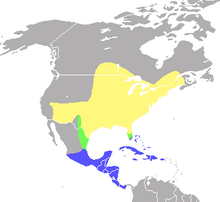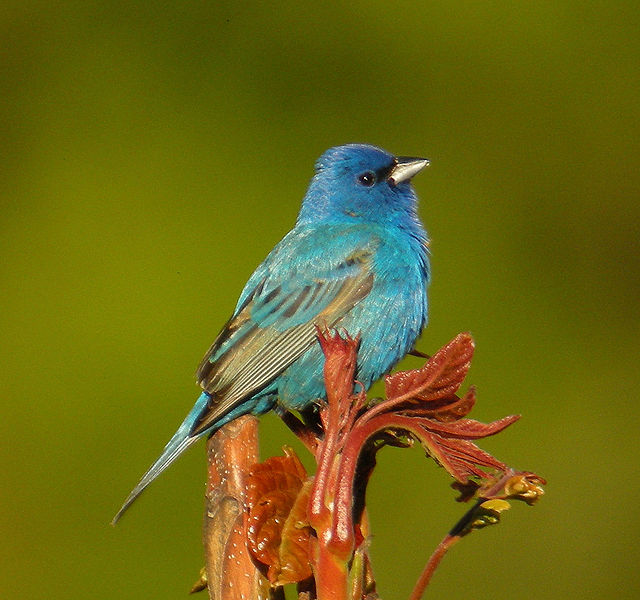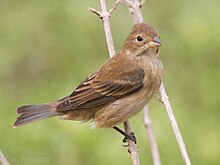
Hi Everybody!
Happy Easter! Look what popped out of a special egg: An Indigo Bunting! He is my Easter Present. The blue, blue bird is the first Visitor of the Spring Migration fly over. The birds have been sighted in High Island, Texas. This beautiful boy is early to this area and came down to feed here at one of my feeding stations. I have shared Wikipedia info below about this little blue bird and Easter.
Then: Surprise: An Easter Parade. Enjoy and spread the Peace of Easter.



https://plus.google.com/u/0/photos/117645114459863049265/albums/6004120321596185777



https://en.wikipedia.org/wiki/Easter
Easter
From Wikipedia, the free encyclopedia
Easter (Old English Ēostre),[nb 1] also called the Pasch[4] or Pascha (the two latter names derived, through Latin: Pascha and Greek Πάσχα Paskha, fromHebrew: פֶּסַח Pesaḥ),[5][6] or Resurrection Sunday,[7][8] is a festival andholiday celebrating the resurrection of Jesus Christ from the dead, described in the New Testament as having occurred three days after his crucifixion byRomans at Calvary.[9][10] It is the culmination of the Passion of Christ, preceded by Lent, a forty-day period of fasting, prayer, and penance.
The last week of Lent is called Holy Week, and it contains the days of theEaster Triduum, including Maundy Thursday (also known as Holy Thursday), commemorating the Last Supper and its preceding foot washing,[11][12] as well as Good Friday, commemorating the crucifixion and death of Jesus.[13] Easter is followed by a fifty-day period called Eastertide, or the Easter Season, ending with Pentecost Sunday.
Easter is a moveable feast, meaning it is not fixed in relation to the civil calendar. The First Council of Nicaea (325) established the date of Easter as the first Sunday after the full moon (the Paschal Full Moon) following the Marchequinox.[14] Ecclesiastically, the equinox is reckoned to be on 21 March (although the astronomical equinox occurs on 20 March in most years), and the "Full Moon" is not necessarily on the astronomically correct date. The date of Easter therefore varies from 22 March to 25 April inclusive. Eastern Christianitybases its calculations on the Julian calendar, whose 21 March corresponds, during the 21st century, to 3 April in the Gregorian calendar, and in which therefore the celebration of Easter varies between 4 April and 8 May.
Easter is linked to the Jewish Passover by much of its symbolism, as well as by its position in the calendar. In many languages, the words for "Easter" and "Passover" are identical or very similar.[15] Easter customs vary across theChristian world, and include sunrise services, exclaiming the Paschal greeting,clipping the church,[16] and decorating Easter eggs, a symbol of the empty tomb.[17][18][19] The Easter lily, a symbol of the resurrection,[20][21] traditionally decorates the chancel area of churches on this day and for the rest of Eastertide.[22] Additional customs that have become associated with Easter and are observed by both Christians and some non-Christians include egg hunting, the Easter Bunny, and Easter parades.[23][24][25] There are also various traditional Easter foods that vary regionally.
| Easter | |
|---|---|

Eastern Orthodox Christian icon depicting theHarrowing of Hell or Descent into Hades[1][2][3](cf. Resurrection of Jesus in Christian art)
| |
| Type | Christian, cultural |
| Significance | Celebrates the resurrection of Jesus |
| Celebrations | Church services, festive family meals, Easter egg hunts and gift-giving |
| Observances | Prayer, all-night vigil, sunrise service |
| Date | Easter |
| 2013 date | 31 March (Western) 5 May (Eastern) |
| 2014 date | 20 April (Western) 20 April (Eastern) |
| 2015 date | 5 April (Western) 12 April (Eastern) |
| Related to | Passover, of which it is regarded the Christian equivalent; Septuagesima,Sexagesima, Quinquagesima,Shrove Tuesday, Ash Wednesday, Clean Monday,Lent, Great Lent, Palm Sunday,Holy Week, Maundy Thursday,Good Friday, and Holy Saturdaywhich lead up to Easter; andThomas Sunday, Ascension,Pentecost, Trinity Sunday, andCorpus Christi which follow it. |









https://en.wikipedia.org/wiki/Indigo_Bunting
Indigo Bunting
From Wikipedia, the free encyclopedia
The Indigo Bunting (Passerina cyanea) is a small seed-eating bird in the familyCardinalidae. It is migratory, ranging from southern Canada to northern Floridaduring the breeding season, and from southern Florida to northern South Americaduring the winter.[2] It often migrates by night, using the stars to navigate.[3] Its habitat is farmland, brush areas, and open woodland.[4] The Indigo Bunting is closely related to the Lazuli Bunting and interbreeds with the species where their ranges overlap.
The Indigo Bunting is a small bird, with a length of 11.5–13 cm (4.5–5.1 in). It displayssexual dimorphism in its coloration; the male is a vibrant blue in the summer and a brown color during the winter months, while the female is brown year-round. The male displays brightly colored plumage during the breeding season to attract a mate. Nest-building and incubation are done solely by the female. The diet of the Indigo Bunting consists primarily of insects during the summer months and seeds during the winter months.
Description[edit]
The Indigo Bunting is a smallish songbird, around the size of a small sparrow. It measures 11.5–15 cm (4.5–5.9 in) long, with a wingspan of 18–23 cm (7.1–9.1 in).[11][2] Body mass averages 14.5 g (0.51 oz), with a reported range of 11.2–21.4 g (0.40–0.75 oz).[12] During the breeding season, the adult male appears mostly a vibrant cerulean blue. Only the head isindigo. The wings and tail are black with cerulean blue edges. In fall and winter plumage, the male has brown edges to the blue body and head feathers, which overlap to make the bird appear mostly brown. The adult female is brown on the upperparts and lighter brown on the underparts. It has indistinct wing bars and is faintly streaked with darker markings underneath.[13] The immature bird resembles the female in coloring, although a male may have hints of blue on the tail and shoulders and have darker streaks on the underside. The beak is short and conical. In the adult female, the bill is light brown tinged with blue, and in the adult male the upper half is brownish-black while the lower is light blue.[14] The feet and legs are black or gray.[15]
Distribution and habitat[edit]
The habitat of the Indigo Bunting is brushy forest edges, open deciduous woods, second growth woodland, and farmland.[4]The breeding range stretches from southern Canada to Maine, south to northern Florida and eastern Texas, and westward to southern Nevada. The winter range begins in southern Florida and central Mexico and stretches south through the West Indies and Central America to northern South America.[2] It has occurred as a vagrant in Antigua and Barbuda, Barbados,Denmark, Ecuador, Germany, Iceland, Ireland, Netherlands, the Netherlands Antilles, Saint Pierre and Miquelon, Serbia and the United Kingdom.[1]
| Indigo Bunting | |
|---|---|
 | |
| Male (above), female (below) | |
| Conservation status | |
| Scientific classification | |
| Kingdom: | Animalia |
| Phylum: | Chordata |
| Class: | Aves |
| Order: | Passeriformes |
| Family: | Cardinalidae |
| Genus: | Passerina |
| Species: | P. cyanea |
| Binomial name | |
| Passerina cyanea (Linnaeus, 1766) | |
 | |
| Range of the Indigo Bunting
Summer-only range Migratory range Winter-only range
| |

A male in breeding plumage



The Easter Parade on Rainbow Creek!!









...this is brendasue signing off from Rainbow Creek. See You next time!

O+O




No comments:
Post a Comment
Hi Everybody! Please say hello and follow so I know you are here! Due to the inconsideration of people trying to put commercials on my blog comment area, I have restricted use of anonymous posts. Sorry that some hurt all.
My public email is katescabin@gmail.com No spammers or trolls